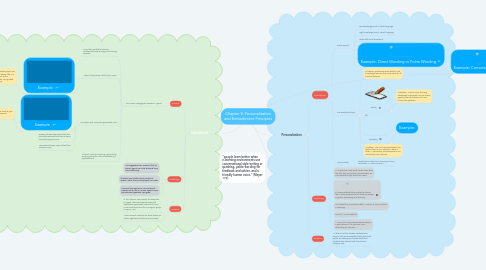
1. Embodiment
1.1. Principle:
1.1.1. On Screen Pedigogical Coaches/ Agents
1.1.1.1. They help guide the learning process.Normally during an e-learning episode.
1.1.1.2. Video of real person with human voice
1.1.1.2.1. Example
1.1.1.3. Animation with computer-generated voice
1.1.1.3.1. Example
1.1.1.3.2. Research shows agents should have humanlike behavior but do not need humanlike appearances.
1.1.1.3.3. Use natural human voice rather than machine voice
1.1.1.4. Are best used for coaching, giving hints, working examples, demonstrations and explanantions
1.2. Psychology:
1.2.1. It is suggested from research that on screen agents can help students learn more effectively.
1.2.2. Students learn better when words are spoken rather than just displayed on screen
1.2.3. Learners treat agents as conversational partners when the on screen agent human embodiment (gestures, eye-gaze)
1.3. Evidence:
1.3.1. In the Atkinson 2002 study, students with an agent that went step-by-step with explanation generated 30 percent more correct solutions than the non-agent group. (Meyer p 193)
1.3.2. More research needs to be done before on screen agents should be recommended
2. "people learn better when e-learning environments use conversational style writing or speaking, polite wording for feedback and advice, and a friendly human voice." (Meyer 179)
3. Example: Conversational vs Formal
4. Personalization
4.1. Principle:
4.1.1. Polite Speech
4.1.1.1. Low knowledge level = Polite language
4.1.1.2. High knowledge level = direct language
4.1.1.3. Helps with social prescence
4.1.1.4. Example: Direct Wording vs Polite Wording
4.1.2. Conversational Style
4.1.2.1. Limitation: politeness works best for low knowledge learners but is not ideal for all levels of learners.
4.1.2.2. Writing
4.1.2.2.1. Limitation: Human voice learning advantage is removed if an on-screen agent is used that does not have human-like gestures.
4.1.2.3. Speaking
4.1.2.3.1. Example:
4.1.2.4. Limitation: Too much personalization can distract learner. For example "wow, hi dude.." Remember conversational is not necessarily over informal.
4.1.3. Voice Quality
4.1.3.1. People learn better from hearing a human voice than a "machine voice".
4.2. Psychology:
4.2.1. 1) People learn and work harder when they feel like they are having a conversation, so conversational style should be used.
4.2.2. 2) Conversational style makes the learner feel a social presence which leads to deeper cognitive processing and learning.
4.2.3. The material is more personable = Learner is more involved in learning!
4.2.4. Formal < Conversational
4.2.5. *** Avoid over-using conversational style to a point where it can become more distracting for learners.
4.3. Evidence:
4.3.1. "In five out of five studies, students who learned with personalization test performed better on subsequent transfer tests than students who learned with formal text" (Meyer p186)
